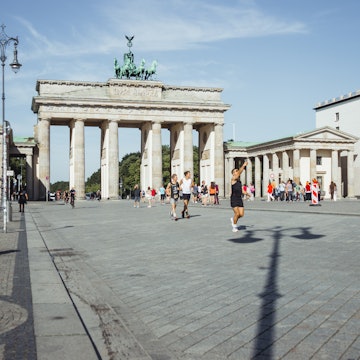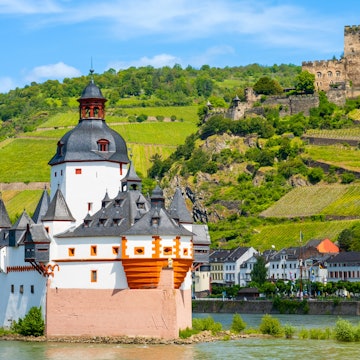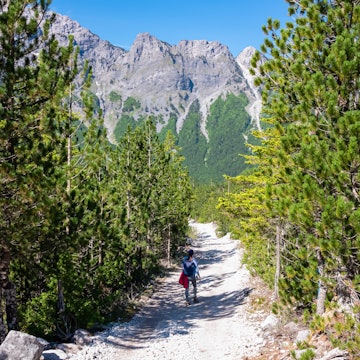
The best time to visit Berlin


Berlin, Germany. frank_peters/Shutterstock
Berlin is a place that makes boredom impossible. Discovering Germany’s capital, and its true depth of historical and cultural richness, gifts you jam-packed days and sprints between attractions. And that’s just the sightseeing!
From its pulsating nightlife to vibrant cultural events and big festivals, Berlin is a city that thrives on creativity and non-stop action. Whatever time of year you visit, excitement, and inevitably exhaustion, will be in store.
To help you make the most of your time and energy, we've gathered all the info you need about what's happening in Berlin and when – you just need to pick the perfect month for you.

June to August is the best time for outdoor party vibes
Summertime brings out the best of Berlin. Sunshine penetrates the generally gruff vibe Germany’s capital is associated with and brings out atmospheric buskers, picnickers and canal-paddlers, and the cheery side of brusque service staff.
Hot summer days send Berliners scurrying to the lakes in town or the surrounding countryside, while gourmets rejoice in the bounty of fresh local produce in the markets. Street life – from beer gardens to flea markets and Späti (convenience store) stoops – takes on party vibes as temperatures rise. But nothing defines Berlin’s most giddy and chaotic season more than its summer street festivals and open-air events.
The festival season kicks off like a Roman candle on the June solstice with Fête de la Musique, comprising hundreds of free concerts on open-air stages. It’s followed in July and August by two party parades, counting hundreds of thousands of revelers apiece. Christopher Street Day, or Berlin Pride, is a celebration of drag, generous body glitter and naked torsos hoisting rainbow flags and blasting boomboxes. Meanwhile, Rave the Planet in August is a techno street march inspired by Berlin’s legendary Love Parade, with DJs bumping bass on stage floats and crowds swathed in neon club gear.
These festivals aside, Berlin is at its most lively and frenetic throughout the entire summer, with late sunsets fueling 24/7 open-air clubbing and group gatherings at parks. Along with the sweltering heat, this party whirlwind can get a little exhausting, which is why many locals retreat to nearby lakes, swimming pools, and well, Greece on their time off.
If you’re in, be ready to accept some of the disadvantages of visiting Berlin during high season – expect long queues at clubs, main sights and attractions, as well as litter everywhere (especially after street parties – public drinking is legal in Germany). Subways and trams are also at their most smelly and crowded. Rent a bike to avoid them!

March to May is the best time for mild weather
Berlin’s shoulder season has a few advantages that make it an unexpectedly superior time to visit. The city isn’t crowded yet, and the weather is at its most pleasant (except for some spring showers). Green lungs have more space to go around, perfect for sunbathing and solitude. All in all, this tends to be the season that locals adore the most and visiting now is a chance to share such revelry.
March, though still definitely jacket-weather, is special as Berliners palpably perk up when life starts moving outdoors. By month’s end, park greenery becomes lush and cherry blossoms burst with color (mid-April’s Cherry Blossom Festival at Gardens of the World is a highlight). Many nightclubs and restaurants begin opening their gardens and terraces respectively – and getting in on a whim is much easier than in high season.
By May Day, Berliners’ favorite festivity of the year, all the anticipation of nice weather is over. During this public holiday, thousands take to Kreuzberg streets and parks; public greens such as Schlesischer Busch runneth over with makeshift DJ booths blasting electronic beats for boogying masses. Once upon a time, May Day was when armed police and leftist demonstrators locked heads, but these days it’s about celebration – although, visitors should still beware of other annoyances like shattered beer bottles, public urination and pickpockets.
At the end of May, Carnaval de Culture takes over Kreuzberg. The festival parade celebrates Berlin's multi-kulti (multicultural) diversity with 4 days of song and culture – think street vendors serving strong caipirinhas, ravishing Carnival costumes and Brazilian samba queens, Chinese lion dancers, and West African drummers parading through the streets. It is just as busy and well-attended as May Day but definitely offers more of a family vibe.

September and October are the best times to live like a local
As summer makes way for fall in September and October, Berlin’s frenzied energy subsides a bit. Berliners, mostly back to work and school, are admittedly sun-fatigued and pour what’s left of their energy into bidding the season adieu. Notoriously sunny weather over the last few years has seen clubs push their closing parties from the end of September into early October. These parties offer the perfect opportunity to rub shoulders with well-versed partiers for intimate sets from Berlin’s best local DJs.
September's Berlin Art Week combines art exhibits, fairs and awards with talks, film and tours. It also provides a chance to see private collections, project spaces and artist studios. October brings the much-loved Berlin Festival of Lights, with 10 days Berlin of "lightseeing" – historic landmarks such as the Fernsehturm (TV Tower), Berliner Dom and the Brandenburg Gate sparkle with illuminations, projections and fireworks.

December is the best for holiday cheer
December days are short and cold but the mood is festive, thanks to dressed-up shop windows, illuminated streets and facades, and Christmas markets redolent with the aroma of roast almonds and mulled wine. Pick up shimmering ornaments or indulge in seasonal treats at dozens of Yuletide markets held throughout the city.
On the night before St Nicholas’ Day (6 December), children
leave their shoes outside their door to receive sweets if they’ve been nice, or
a stone if they’ve been naughty; eventually this developed into Santa’s international
rounds. Germans are pretty attached to the original – all kinds of clubs hold
Nikolaus parties, complete with costumed St Nicks.

November and January are the best times for budget travel
While locals flock elsewhere due to cold temps and shorter days, it can still be a great time to visit – far fewer visitors at museums and galleries, hearty German dishes taste even better, cozy candlelit haunts come to life and accommodation is at its cheapest. Hotel rates take a dip and many Berliners sublet their apartments – and if you're willing to be a trusty plant nanny or cat-sitter, some may even let you stay for free (Facebook groups and websites like WG-Gesucht are great places to find sublets).
If you can put up with dark skies and gray cityscapes, there are even a couple more perks: weekend dinner reservations are easier to come by on short notice, plus dance floors around the city gloriously thin out (read: shorter queues at iconic spots like Berghain and KitKatClub).
New Year’s Eve, or in German, Silvester, is notoriously bliss or bust in the capital depending on whether you prefer relaxation or rowdiness. It’s a chance to hit the streets and the big official bash at Brandenburg Gate, guzzling bubbly from bottles and dodging fireworks from amateur pyros.
Later in January brings Berlin’s Green Week, a 9-day sustainability fair and a serious cultural highlight for tasty food and innovative fashion.















